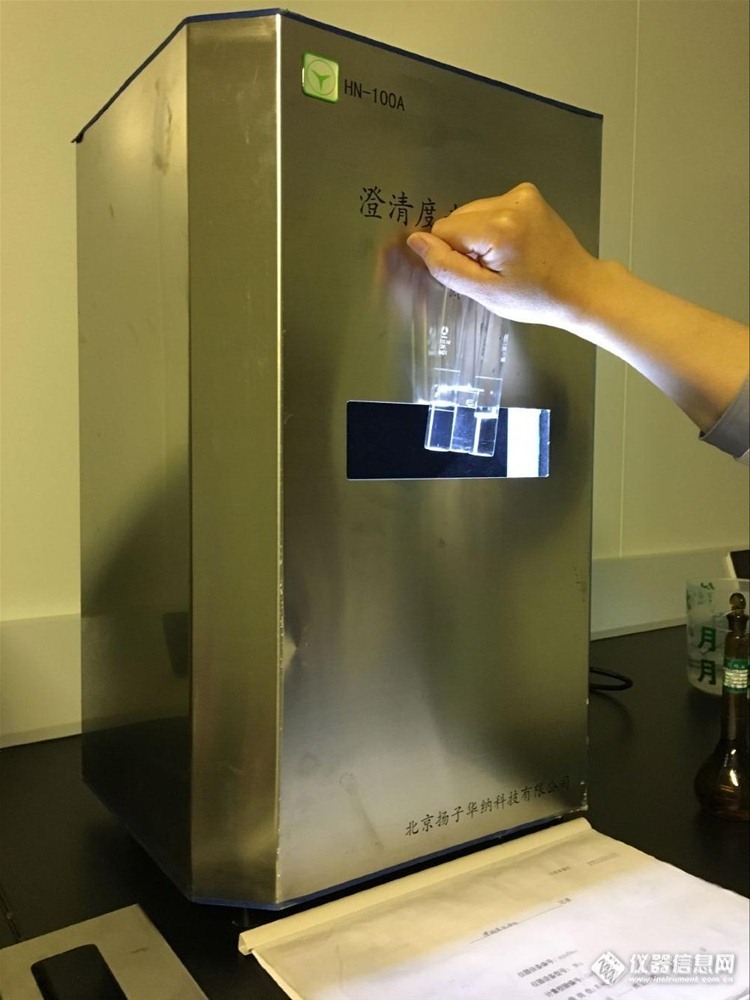溶液澄清度 中国药典:
附录Ⅸ B澄清度检查法
本法系在室温条件下,将用水稀释至一定浓度的供试品溶液与等量的浊度标 准液分别置于配对的比浊用玻璃管(内径 15~16mm,平底,具塞,以无色、透 明、中性硬质玻璃制成)中,在浊度标准液制备 5 分钟后,在暗室内垂直同置于伞棚灯下,照度为 1000 lx,从水平方向观察、比较;用以检查溶液的澄清度或其浑浊程度。除另有规定外,供试品溶解后应立即检视。
品种项下规定的“澄清”,系指供试品溶液的澄清度相同于所用溶剂,或未 超过 0.5 号浊度标准液。“几乎澄清”则指供试品溶液的浊度介于 0.5 号至 1 号浊度标准液的浊度之间。
浊度标准贮备液的制备 称取于105℃干燥至恒重的硫酸肼1.00g,置100ml 量瓶中,加水适量使溶解,必要时可在 40℃的水浴中温热溶解,并用水稀释至 刻度,摇匀,放置 4~6 小时;取此溶液与等容量的 10%乌洛托品溶液混合,摇匀,于 25℃避光静置 24 小时,即得。本液置冷处避光保存,可在两个月内使用,用前摇匀。
浊度标准原液的制备 取浊度标准贮备液 15.0ml,置 1000ml 量瓶中,加水 稀释至刻度,摇匀,取适量,置 1cm 吸收池中,照紫外-可见分光光度法(附录Ⅳ A),在 550nm 的波长处测定,其吸光度应在 0.12~0.15 范围内。本液应在 48小时内使用,用前摇匀。
浊度标准液的制备 取浊度标准原液与水,按下表配制,即得。本液应临用 时制备,使用前充分摇匀。
级号 0.5 1 2 3 4
浊度标准原液/ml 2.50 5.0 10.0 30.0 50.0
水/ml 97.50 95.0 90.0 70.0 50.0
欧洲药典:
Clarity and degree of opalescence of liquids
VISUAL METHOD一般方法
Using identical test-tubes of colourless, transparent, neutral glass with a flat base and an internal diameter of 15-25 mm, compare the liquid to be examined with a reference suspension freshly prepared as described below, the depth of the layer being 40 mm. Compare the solutions in diffused daylight 5 min after preparation of the reference suspension, viewing vertically against a black background. The diffusion of light must be such that reference suspension I can readily be distinguished from water R, and that reference suspension II can readily be distinguished from reference suspension I.
在内径15~25mm,平底,无色、透明、中性玻璃管中,加入等量的供试溶液与浊度标准液,使液位的深度都为40mm,按如下所述方法进行比较。浊度标准液制备5分钟后,以色散自然光照射浊度标准溶液和供试溶液,在黑色背景下从垂直方向观察、比较澄清度或浑浊程度。色散自然光必须较容易区分浊度标准溶液Ⅰ与水,浊度标准溶液Ⅱ与浊度标准溶液Ⅰ
A liquid is considered clear if its clarity is the same as that of water R or of the solvent used when examined under the conditions described above, or if its opalescence is not more pronounced than that of reference suspension I.
如果供试溶液的澄清、透明程度与水相同,或者与所用溶剂相同,或者其澄清度不超过Ⅰ号浊度标准溶液,那么可判定该溶液为澄清。
Hydrazine sulfate solution. Dissolve 1.0 g of hydrazine sulfate R in water R and dilute to 100.0 mL with the same solvent. Allow to stand for 4-6 h.
硫酸肼溶液:取1.0g硫酸肼溶于水,加水稀释至100.0ml,静置4~6小时。
Hexamethylenetetramine solution. In a 100 mL ground-glass-stoppered flask, dissolve 2.5 g of hexamethylenetetramine R in 25.0 mL of water R.
乌洛托品(六亚甲基四胺)溶液 :在100ml容量瓶中,以25.0ml水溶解2.5g乌洛托品。
Primary opalescent suspension (formazin suspension).
To the examethylenetetramine solution in the flask add 25.0 mL of the hydrazine sulfate solution. Mix and allow to stand for 24 h. This suspension is stable for 2 months, provided it is stored in a glass container free from surface defects. The suspension must not adhere to the glass and must be well mixed before use.
浊度标准贮备液:在存放乌洛托品溶液的100ml容量瓶中,加25.0ml的硫酸肼溶液。混合,静置24小时,贮存在无表面要求的玻璃容器中,可在2个月内使用。该浊度液不得黏附玻璃,用前必须充分摇匀。
Standard of opalescence. Dilute 15.0 mL of the primary opalescent suspension to 1000.0 mL with water R. This suspension is freshly prepared and may be stored for up to 24 h.
浊度标准原液:取浊度标准贮备液15ml,加水稀释、定容至1000ml。该液临用前制备,至多保存24小时。
Reference suspensions. Prepare the reference suspensions according to Table 2.2.1.-1. Mix and shake before use.
浊度标准液:由浊度标准原液与水按表1-1配制,即得。本液应临用前配制。
Table 1.-1
I II III IV
Standard of opalescence 5.0 mL 10.0 mL 30.0 mL 50.0 mL
Water R 95.0 mL 90.0 mL 70.0 mL 50.0 mL
表 1.-1
I II III IV
浊度标准液 5.0 mL 10.0 mL 30.0 mL 50.0 mL
水 95.0 mL 90.0 mL 70.0 mL 50.0 mL
Turbidity standard. The formazin suspension prepared by mixing equal volumes of the hydrazine sulfate solution and the hexamethylenetetramine solution is defined as a 4000 NTU (nephelometric turbidity units) primary reference standard. Reference suspensions I, II, III and IV have values of 3 NTU, 6 NTU, 18 NTU and 30 NTU respectively. Stabilised formazin suspensions that can be used to prepare stable, diluted turbidity standards are available commercially and may be used after comparison with the standards prepared as described.
浊度标准:乳光悬浊贮备液定为4000NTU(比浊测定法的浊度单位)储备液对照标准.浊度标准液I, II, III 和 IV相应的NTU值分别是3 NTU, 6 NTU, 18 NTU 和 30 NTU。稳定的乳光悬浊贮备液可用于稀释制备浊度标准,具有现实的商业价值,也可以与上述的标准化制备进行较。
Formazin has several desirable characteristics that make it an excellent turbidity standard. It can be reproducibly prepared from assayed raw materials. The physical characteristics make it a desirable light-scatter calibration standard. The formazin polymer consists of chains of different lengths, which fold into random configurations. This results in a wide assay of particle shapes and sizes, which analytically fits the possibility of different particle sizes and shapes that are found in the real samples. Due to formazin’s reproducibility, scattering characteristics and traceability, instrument calibration algorithms and performance criteria are mostly based on this standard.
因福马尔肼具有一些我们所希望的特性,所以它是一种非常优良的浊度标准物。它可以从被测原料中反复制备。具有所想要的光闪射校正标准化的物理特性。福马尔肼聚合物由不同长度的链组成,他们可以折成各种形状,应此可以分析不同大小和形状的粒子。这一特性使得我们可以对现实样品中所具有的不同大小及性状的粒子进行测定。由于。福马尔肼具有可重复性、光散射性、可描绘性、仪器校准可算和操作标准化的特性,使其成为了浊度标准物。
instrumental methods 仪器方法简介
Introduction
The degree of opalescence may also be determined by instrumental measurement of the light absorbed or scattered on account of submicroscopic optical density inhomogeneities of opalescent solutions and suspensions. 2 such techniques are nephelometry and turbidimetry. For turbidity measurement of coloured samples, ratio turbidimetry and nephelometry with ratio selection are used.
该仪器法是根据浑浊液和悬浊液亚显微镜光密度的不均一性来测量光的吸收或光的散射,即散射测浊法和透射测浊法。对于有色样品的浊度测试法,要用到比率透射比浊法和可选择比率的散射比浊法。
The light scattering effect of suspended particles can be measured by observation of either the transmitted light (turbidimetry) or the scattered light (nephelometry). Ratio
悬浮颗粒的光散射效应可以通过无论是透射光观察测定(比浊法)或散射光(比浊法)。比




